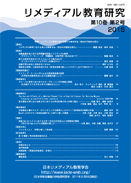Volume 10, Issue 2
Displaying 1-18 of 18 articles from this issue
- |<
- <
- 1
- >
- >|
Special Issue: New Teaching Methods in Developmental Education (Searching for the Key to Successful Practice)
[Overview]
-
2015 Volume 10 Issue 2 Pages 119-123
Published: October 31, 2015
Released on J-STAGE: February 01, 2017
Download PDF (504K)
[Interpretation]
-
2015 Volume 10 Issue 2 Pages 124-133
Published: October 31, 2015
Released on J-STAGE: February 01, 2017
Download PDF (477K) -
2015 Volume 10 Issue 2 Pages 134-142
Published: October 31, 2015
Released on J-STAGE: February 01, 2017
Download PDF (666K) -
2015 Volume 10 Issue 2 Pages 143-151
Published: October 31, 2015
Released on J-STAGE: February 01, 2017
Download PDF (607K) -
2015 Volume 10 Issue 2 Pages 152-159
Published: October 31, 2015
Released on J-STAGE: February 01, 2017
Download PDF (1085K)
[Practical Research Paper]
-
2015 Volume 10 Issue 2 Pages 160-170
Published: October 31, 2015
Released on J-STAGE: February 01, 2017
Download PDF (643K)
[Practical Report]
-
2015 Volume 10 Issue 2 Pages 171-182
Published: October 31, 2015
Released on J-STAGE: February 01, 2017
Download PDF (938K)
- - -
[Practical Report]
-
2015 Volume 10 Issue 2 Pages 183-193
Published: October 31, 2015
Released on J-STAGE: February 01, 2017
Download PDF (400K) -
2015 Volume 10 Issue 2 Pages 194-203
Published: October 31, 2015
Released on J-STAGE: February 01, 2017
Download PDF (961K)
[Review of Teaching Methods]
-
2015 Volume 10 Issue 2 Pages 204-210
Published: October 31, 2015
Released on J-STAGE: February 01, 2017
Download PDF (802K) -
2015 Volume 10 Issue 2 Pages 211-214
Published: October 31, 2015
Released on J-STAGE: February 01, 2017
Download PDF (540K)
[Data]
-
2015 Volume 10 Issue 2 Pages 215-221
Published: October 31, 2015
Released on J-STAGE: February 01, 2017
Download PDF (426K)
[Introduction of Book]
-
2015 Volume 10 Issue 2 Pages 222
Published: October 31, 2015
Released on J-STAGE: February 01, 2017
Download PDF (278K)
[Correction Report]
-
2015 Volume 10 Issue 2 Pages 223
Published: October 31, 2015
Released on J-STAGE: February 01, 2017
Download PDF (164K)
- - -
[Announcements]
-
2015 Volume 10 Issue 2 Pages 224-230
Published: October 31, 2015
Released on J-STAGE: February 01, 2017
Download PDF (341K) -
2015 Volume 10 Issue 2 Pages 231-232
Published: October 31, 2015
Released on J-STAGE: February 01, 2017
Download PDF (170K) -
2015 Volume 10 Issue 2 Pages 233-235
Published: October 31, 2015
Released on J-STAGE: February 01, 2017
Download PDF (222K)
[Editor's Postscript]
-
2015 Volume 10 Issue 2 Pages 236
Published: October 31, 2015
Released on J-STAGE: February 01, 2017
Download PDF (213K)
- |<
- <
- 1
- >
- >|
